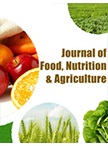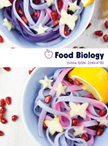Effect of smoking, drying and the combination of smoking-drying on the nutritional and sensory attributes of catfish (Clarias gariepinus)
DOI:
https://doi.org/10.21839/jfna.v1i1.133Keywords:
Dried and smoked fish, fresh catfish, free fatty acids, free fatty acidssmoking, total plated countAbstract
Poor post harvesting technology such as handling, preservation and processing can lead to an unhealthy situation through massive spoilage and waste. This study assessed the effect of smoking, drying and the combination of smoking-drying on the nutritional and sensory attributes of catfish. Six kilograms of average fresh catfish were washed, eviscerated, drained, and divided into four portions of 1.5 kg each. Sample A served as control (fresh fish), while samples B, C, D were dried, smoked, dried and smoked fish respectively. Samples were analyzed using standard methods. The results of proximate analyses of samples showed that the moisture content ranged from 20.1 to 75.0 %, the protein content from 21.7 to 63.0 %, the fat content from 0.5 to 8.6 %, while the crude fibre ranged from 0.0 to 0.04 %. The total ash ranged from 1.1 to 4.9 %, while Carbohydrate (NFE) ranged from 0.1 to 3.5 %. Significant difference (p>0.05) was observed in the free fatty acids and pH of sample C compared to other samples. The total plate count ranged from 2.4 to 4.3x10-5 CFU/g. The sensory attributes result showed that sample D was the most preferred and acceptable. The study showed that dried-smoked fish had a better quality and was more preferred for consumption than singly dried or smoked catfish
Downloads
References
Agbon, A.O., Ezeri, G.N.O., Ikenwiewe, B.N., Alegbleye, N.O., and Akomolade, D.T. (2002). A comparative study of different storage methods on the shelf life of smoked current fish. Journal of Aquatic Sciences, 17(2), 134-136.
Akande, G.R., Oladosu O.S., and Tobor J.G. (1998). A comparative technical and economical appraisal of fish smoking: Two traditional ovens and a new improved magbon Alade oven. FAO Fisheries Report, 574, 70-75.
Akinneye, J.O., I.A. Amoo and Arannilewa., S.T. (2007). Effect of drying methods on the nutritional composition of three species of (Bonga sp., Sardinella sp. and Heterotis niloticus). Journal of Fisheries International, 2(1): 99-103.
Akinola, O.A., Akinyemi, A.A., and Bolaji, B.O. (2006). Evaluation of traditional and solar drying systems towards enhancing fish storage and preservation in Nigeria (Abeokuta Local Government as a case study). Journal of Fisheries International, 1(2): 44-49.
Ali, A., Ahmadou, A., Mohamadou, B.A., Saidou, C., and Tenin, D. (2011). Influence of traditional drying and smoking drying on the quality of three fish species (Tilapia nilotica, Silurus glanis and Arius parkii) from lagodo lake, Cameroon. Journal of Animal and Veterinary Advances, 10(3), 301-306.
AOAC (2005). Official Methods of Analysis, 15th Edition. Association of Analytical Chemists, Washington DC.
Cardinal, M., Knockaert, C., Torrissen, O., Sigurgisladottir, S., Mørkøre, T., Thomassen, M., Vallet, J.L. (2001). Food Research International, 34, 537-550.
Eyo, A.A. (2001). Fish Processing technology in the tropics. University of Ilorin press, Nigeria. pp.112-129.
Foline, O.F., Rachael, A.M., Iyabo, B.E., and Fidelis, A.E. (2011). Proximate composition of catfish (Clarias gariepinus) smoked in Nigerian stored products research institute (NSPRI): Developed kiln. International Journal of Fisheries and Aquaculture, 3(5), 96-98.
Harrigan, W.F., and MacCance, M.E. (1982). Laboratory methods in food and dairy microbiology (6th ed.), London: Academic press, 48 – 167.
Hartman, P.A. (1985). Coliform counts in dairy and dairy products. In: Standard methods for the examination of dairy products (15th ed), Washington D.C. American Public Health Association, 150 – 153.
Ikeme, A. I., and Gugnani, H. C. (1988). Effect of smoking time on quality of hot smoked mackerel. FAO expert consultation on Fish Technology in Africa. FAO Fisheries Report, 400.
Ime-Ibanga, U., and Fakunle J.O. (2008). Effect of smoking and oven drying on the proximate composition and sensory qualities of salted and saltless Clarias gariepinus. Proceedings of 23rd Anniversary Conference FISON, Kaduna, 71-74.
Iwe, M.O. (2002). Handbook on sensory methods and analysis. Enugu. Rojoint communications services limited.
Nelson, J.S. (2006). Fishes of the world. Canada, Johowiley & Sons, Inc.
Ogbona, C., and Ibrahim, M.S. (2009). Effect of drying methods on proximate composition of catfish (Clarias gariepinus). World Journal of Agricultural Sciences, 5(1), 114-116.
Okonta, A.A., and J.K. Ekelemu, (2005). A prelimnary study of micro-organisms associated with fish spoilage in Asaba, Southern Nigeria. Proceedings of the 20th Annual Conference of the Fisheries Society of Nigeria (FISON), Port Harcourt, 14th-18th November, pp: 557-560.
Tawari, C.C., and Abowei, J.F.N. (2011). Traditional Fish Handling and Preservation in Nigeria. Asian Journal of Agricultural Sciences, 3(6), 427-436.
Tobor, J.G. (2004). A review of the fish industry in Nigeria and status of fish preservation method and future growth perquisite to cope with anticipated increase in production. NIOMR Technical paper, Nigerian Institute for Oceanography and Marine Research, Nigeria.






 .
.